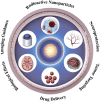Breaking the barrier: Nanoparticle-enhanced radiotherapy as the new vanguard in brain tumor treatment
- PMID: 39021831
- PMCID: PMC11252536
- DOI: 10.3389/fphar.2024.1394816
Breaking the barrier: Nanoparticle-enhanced radiotherapy as the new vanguard in brain tumor treatment
Abstract
The pursuit of effective treatments for brain tumors has increasingly focused on the promising area of nanoparticle-enhanced radiotherapy (NERT). This review elucidates the context and significance of NERT, with a particular emphasis on its application in brain tumor therapy-a field where traditional treatments often encounter obstacles due to the blood-brain barrier (BBB) and tumor cells' inherent resistance. The aims of this review include synthesizing recent advancements, analyzing action mechanisms, and assessing the clinical potential and challenges associated with nanoparticle (NP) use in radiotherapy enhancement. Preliminary preclinical studies have established a foundation for NERT, demonstrating that nanoparticles (NPs) can serve as radiosensitizers, thereby intensifying radiotherapy's efficacy. Investigations into various NP types, such as metallic, magnetic, and polymeric, have each unveiled distinct interactions with ionizing radiation, leading to an augmented destruction of tumor cells. These interactions, encompassing physical dose enhancement and biological and chemical radio sensitization, are crucial to the NERT strategy. Although clinical studies are in their early phases, initial trials have shown promising results in terms of tumor response rates and survival, albeit with mindful consideration of toxicity profiles. This review examines pivotal studies affirming NERT's efficacy and safety. NPs have the potential to revolutionize radiotherapy by overcoming challenges in targeted delivery, reducing off-target effects, and harmonizing with other modalities. Future directions include refining NP formulations, personalizing therapies, and navigating regulatory pathways. NERT holds promise to transform brain tumor treatment and provide hope for patients.
Keywords: blood-brain barrier; brain tumor; clinical translation; nanoparticle-enhanced radiotherapy; radio sensitization; regulatory landscapes.
Copyright © 2024 Liu, Li, Liang, Sun, Shao, Hu and Xing.
Conflict of interest statement
The authors declare that the research was conducted in the absence of any commercial or financial relationships that could be construed as a potential conflict of interest.
Figures





Similar articles
-
Nanoparticle-Driven Radiotherapy for Pancreatic Cancer: Pioneering Precision Biotherapy for Enhanced Efficacy and Reduced Toxicity.Cancer Biother Radiopharm. 2025 May 21. doi: 10.1089/cbr.2025.0088. Online ahead of print. Cancer Biother Radiopharm. 2025. PMID: 40398923
-
Nanoparticle-Based Combinational Strategies for Overcoming the Blood-Brain Barrier and Blood-Tumor Barrier.Int J Nanomedicine. 2024 Mar 13;19:2529-2552. doi: 10.2147/IJN.S450853. eCollection 2024. Int J Nanomedicine. 2024. PMID: 38505170 Free PMC article. Review.
-
Recommendations for clinical translation of nanoparticle-enhanced radiotherapy.Br J Radiol. 2018 Dec;91(1092):20180325. doi: 10.1259/bjr.20180325. Epub 2018 Sep 17. Br J Radiol. 2018. PMID: 30179039 Free PMC article.
-
Delivery of Nanoparticle-Based Radiosensitizers for Radiotherapy Applications.Int J Mol Sci. 2019 Dec 31;21(1):273. doi: 10.3390/ijms21010273. Int J Mol Sci. 2019. PMID: 31906108 Free PMC article. Review.
-
Application of High-Z Nanoparticles to Enhance Current Radiotherapy Treatment.Molecules. 2024 May 22;29(11):2438. doi: 10.3390/molecules29112438. Molecules. 2024. PMID: 38893315 Free PMC article. Review.
Cited by
-
Advances in nanoparticle-based radiotherapy for cancer treatment.iScience. 2024 Dec 14;28(1):111602. doi: 10.1016/j.isci.2024.111602. eCollection 2025 Jan 17. iScience. 2024. PMID: 39834854 Free PMC article. Review.
-
Progress in Drug Delivery Systems Based on Nanoparticles for Improved Glioblastoma Therapy: Addressing Challenges and Investigating Opportunities.Cancers (Basel). 2025 Feb 19;17(4):701. doi: 10.3390/cancers17040701. Cancers (Basel). 2025. PMID: 40002294 Free PMC article. Review.
-
State-of-the-art photodynamic therapy for malignant gliomas: innovations in photosensitizers and combined therapeutic approaches.Explor Target Antitumor Ther. 2025 Mar 28;6:1002303. doi: 10.37349/etat.2025.1002303. eCollection 2025. Explor Target Antitumor Ther. 2025. PMID: 40177536 Free PMC article. Review.
-
Recent Treatment Strategies and Molecular Pathways in Resistance Mechanisms of Antiangiogenic Therapies in Glioblastoma.Cancers (Basel). 2024 Aug 27;16(17):2975. doi: 10.3390/cancers16172975. Cancers (Basel). 2024. PMID: 39272834 Free PMC article. Review.
-
Drug-tolerant persister cells in acute myeloid leukemia: pressing challenge and promising new strategies for treatment.Front Med (Lausanne). 2025 May 14;12:1586552. doi: 10.3389/fmed.2025.1586552. eCollection 2025. Front Med (Lausanne). 2025. PMID: 40443513 Free PMC article. Review.
References
-
- Alijagic A., Gaglio D., Napodano E., Russo R., Costa C., Benada O., et al. (2019). Titanium dioxide nanoparticles temporarily influence the sea urchin immunological state suppressing inflammatory-relate gene transcription and boosting antioxidant metabolic activity. J. Hazard. Mater. 384, 121389. 10.1016/j.jhazmat.2019.121389 - DOI - PubMed
Publication types
LinkOut - more resources
Full Text Sources
Miscellaneous

